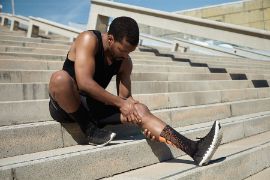A muscle spasm refers to a sudden, sharp, and involuntary muscle contraction. The painful spasm that develops is due to the muscle remaining in a contracted position. One of the most common types of muscle spasms occur in the calf muscles, which is often called a Charley Horse. They may also develop in the hand muscles, especially in musicians. Spasms may even arise in muscles within the spine or internal organs such as the bladder or colon.
There are a number of factors that may lead to muscle spasms including dehydration, nutrient deficiencies, the overuse of muscles, an injury (e.g., muscle strain), circulation problems, nerve entrapments, and certain conditions (e.g., diabetes).
Exercise-associated muscle cramps are the most frequent issue that requires therapeutic intervention, especially during sports activities.
 Dehydration and nutrient deficiencies are often linked as the dehydration process involves the loss of minerals (electrolytes) and vitamins, and this typically leads to muscle spasms as well as muscle weakness. Salt, potassium, and magnesium loss in particular, increase the risk of experiencing muscle spasms. Staying hydrated and drinking liquids with electrolytes helps target these types of muscle spasms.
Dehydration and nutrient deficiencies are often linked as the dehydration process involves the loss of minerals (electrolytes) and vitamins, and this typically leads to muscle spasms as well as muscle weakness. Salt, potassium, and magnesium loss in particular, increase the risk of experiencing muscle spasms. Staying hydrated and drinking liquids with electrolytes helps target these types of muscle spasms.
Spasms that develop during or directly after exercising in healthy individuals, who do not have a history of nerve or hormone-related conditions, are referred to as exercise-associated muscle cramps. These types of muscle spasms are distinct from those that are caused by an underlying medical condition because exercise-induced spasms typically affect one location (e.g., hamstrings, triceps, and quadriceps) and often cause visible knotting or bulging, stiffness, short-term pain, and soreness. Conversely, spasms that occur as a result of a specific health issue may simultaneously affect several muscles.
Some people experience nighttime muscle spasms that appear to be linked to muscle fatigue that develops during the day, as well as circulatory problems that are associated with certain conditions such as sclerosis and spinal stenosis. Pregnant individuals commonly experience leg muscle spasms at night, potentially due to changes in blood volume, circulation, nutrient absorption by the developing fetus, and changing hormones.
Unfortunately, the exact cause of muscle spasms is not always clear, and persistent spasms indicate that it is time to seek professional help for this issue. Research shows that physiotherapy accelerates the healing of muscle injuries, as well as nerve and muscle dysfunction that contributes to muscle spasms.
A physiotherapy consultation typically involves a thorough physical examination that helps pinpoint the cause of a specific injury or ongoing problem that may be contributing to the pain and discomfort of muscle spasms. More specifically, the medical history is reviewed, followed by an assessment of an individual's posture while sitting, standing, and walking in order to determine whether muscular imbalances may be present. A physiotherapist will also palpate (touch and feel) the muscles to assess how the structure compares to the opposite side or other muscles in the body, and see if there is resting tension in the muscle, or if it has a tear or gap. The individual may also be asked to stimulate the muscle region where the spasms usually occur.
If a specific movement or stretching position causes a spasm, the physiotherapist should be able to feel strong tension develop in the muscle. This type of evaluation allows a physiotherapist to design a therapeutic plan that is specific to the individual’s needs. Accordingly, physiotherapy techniques such as tissue compression and passive stretching have been shown to effectively target muscle spasms. If you have been suffering from recurring muscle spasms, working with a physiotherapist may help you identify the cause and prevent it from continuing to happen. Muscle spasms can become debilitating, but guidance from a physiotherapist can keep you active and healthy.
References
1. Giuriato G, Pedrinolla A, Schena F, Venturelli M. Muscle cramps: A comparison of the two-leading hypothesis. J Electromyogr Kinesiol. 2018;41:89-95.
2. Miller KC, Stone MS, Huxel KC, Edwards JE. Exercise-associated muscle cramps: causes, treatment, and prevention. Sports Health. 2010;2(4):279-83.
3. Schwellnus MP, Derman EW, Noakes TD. Aetiology of skeletal muscle 'cramps' during exercise: a novel hypothesis. J Sports Sci. 1997;15(3):277-85.
4. Lo Coco D, La Bella V. Fatigue, sleep, and nocturnal complaints in patients with amyotrophic lateral sclerosis. Eur J Neurol. 2012;19(5):760-3.
5. Matsumoto M, Watanabe K, et al. Nocturnal leg cramps: a common complaint in patients with lumbar spinal canal stenosis. Spine (Phila Pa 1976). 2009;34(5):E189-94.
6. Helin P. Physiotherapy and electromyography in muscle cramp. Br J Sports Med. 1985;19(4):230-1.









